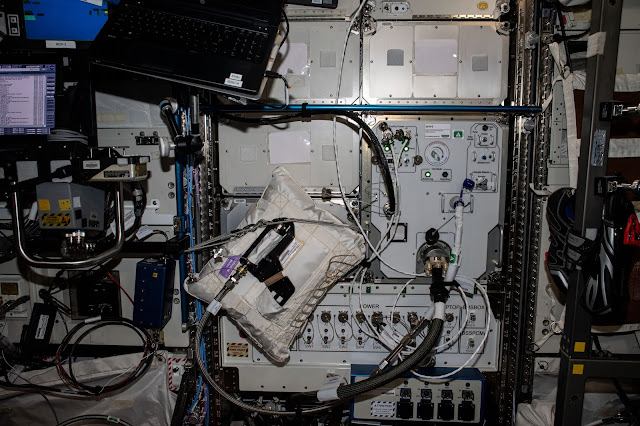ISS - Expedition 64 Mission patch.
Mar 5, 2021
The week of March 1, crew members aboard the International Space Station conducted a number of scientific experiments, including a demonstration of water recovery technology, analyzing how gravity affects cell gene expression, and testing new cooling technology for spacesuits.
International Space Station (ISS). Animation Credit: ESA
The seven crew members currently inhabiting the station include four from NASA’s Commercial Crew Program, providing increased crew time for science activities on the orbiting lab. The space station has been continuously inhabited by humans for 20 years and has supported many scientific breakthroughs during that time. The station provides a platform for long-duration research in microgravity and for learning to live and work in space, experience that supports Artemis, NASA’s program to go forward to the Moon and on to Mars.
Here are details on some of the microgravity investigations currently taking place:
Improving water recovery
Image above: The Brine Processor Assembly (BPA), which uses a dual-membrane bladder to recover additional available water from urine. Image Credits: NASA/Robert Markowitz.
The space station’s Environmental Control and Life Support System (ECLSS) includes a Water Recovery System that provides clean water for astronaut use by recycling urine; condensate from crew sweat, respiration, and hygiene; and water recovered from the Air Revitalization System. Part of this system, the Urine Processor Assembly, recovers 87% of water from urine. The Brine Processor System (BPS) demonstrates technology to purify and recover a higher percentage of available water from urine, which will be necessary on long-duration exploration missions. This technology ultimately could help scientists build better systems for future Moon and Mars missions and habitats. During the week, crew members worked on installing the BPS.
Examining gravity’s effect on gene translation changes
The crew conducted operations during the week in support of the Ribosome Profiling experiment from the Japan Aerospace Exploration Agency (JAXA). In 4 billion years or so of life on Earth, living things have evolved to function in Earth’s gravity. However, scientists are not sure how cells use gravity in gene expression. This investigation uses a technique called ribosome profiling to evaluate genome-wide changes in gene translation in cell cultures in microgravity. Results could provide insight into how gravity affects gene expression.
Designing a cooler space suit
Image above: Set up on the space station for the SERFE investigation, which demonstrates a technology using evaporation of water to remove heat from spacesuits. Image Credit: NASA.
SERFE demonstrates a technology using evaporation of water to remove heat from spacesuits and maintain appropriate temperatures for crew members and equipment during space walks. The investigation determines whether microgravity affects performance of the technology and evaluates its effect on contamination and corrosion of spacesuit material. During the week, crew members visually checked a SERFE water sample after approximately 48 hours of incubation and reported observations to the ground.
Other investigations on which the crew performed work:
Image above: NASA astronaut Shannon Walker sets up hardware for the PBRE investigation, which explores how liquids and gases behave together in microgravity. Results may enable design of more energy efficient and lightweight thermal management and life support systems for future space exploration missions. Image Credit: NASA.
- The Packed Bed Reactor Experiment-Water Recovery (PBRE-WR) investigation examines flow rates of gas and liquid through filters in the space station water processor.
https://www.nasa.gov/mission_pages/station/research/experiments/explorer/Investigation.html?#id=8068
- A-HoSS demonstrates software to modify the Hybrid Electronic Radiation Assessor (HERA), the primary radiation detection system for Orion and certified for flight on Artemis 2, to operate on the space station. The investigation provides an opportunity to evaluate this hardware in the space radiation environment prior to the Artemis 2 flight.
https://www.nasa.gov/mission_pages/station/research/experiments/explorer/Investigation.html?#id=8234
- RTPCG-2 demonstrates new methods for producing high-quality crystals for up to eight proteins for detailed analysis on Earth. Previous work has shown that microgravity produces high-quality protein crystals that can be analyzed to identify possible targets for drugs to treat disease.
https://www.nasa.gov/mission_pages/station/research/experiments/explorer/Investigation.html?#id=8073
- Mochii is a miniature scanning electron microscope with spectroscopy capabilities that can conduct real-time, on-site imaging of particles on the space station and measure their composition. Small and microscopic particles can cause vehicle and equipment malfunctions and threaten crew health.
https://www.nasa.gov/mission_pages/station/research/experiments/explorer/Facility.html?#id=7657
- Antimicrobial Coatings tests a coating to control microbial growth on several different materials that represent high-touch surfaces. Some microbes change characteristics in microgravity, potentially creating new risks to crew health and spacecraft.
https://www.nasa.gov/mission_pages/station/research/experiments/explorer/Investigation.html?#id=8352
- Food Acceptability looks at how the appeal of food changes during long-duration missions. Whether crew members like and actually eat foods directly affects caloric intake and associated nutritional benefits.
https://www.nasa.gov/mission_pages/station/research/experiments/explorer/Investigation.html?#id=7562
- ISS Ham Radio gives students in schools, camps, museums and planetariums around the world the opportunity to converse with astronauts on the space station. To date, more than 1,300 organizations from 63 countries have contacted the space station using ham radio.
https://www.nasa.gov/mission_pages/station/research/experiments/explorer/Investigation.html?#id=337
Image above: The city lights of Montreal as seen from the International Space Station as it orbits 262 miles above Quebec, Canada. Image Credit: NASA.
- Sally Ride EarthKAM allows students to remotely control a digital camera on the space station to take photographs of features and phenomena on Earth. The EarthKAM team posts the students’ images online for the public and participating classrooms to view.
https://www.nasa.gov/mission_pages/station/research/experiments/explorer/Investigation.html?#id=87
Related links:
Expedition 64: https://www.nasa.gov/mission_pages/station/expeditions/expedition64/index.html
Brine Processor System (BPS): https://www.nasa.gov/mission_pages/station/research/experiments/explorer/Investigation.html?#id=8102
Ribosome Profiling: https://www.nasa.gov/mission_pages/station/research/experiments/explorer/Investigation.html?#id=7985
SERFE: https://www.nasa.gov/mission_pages/station/research/experiments/explorer/Investigation.html?#id=7514
ISS National Lab: https://www.issnationallab.org/
Spot the Station: https://spotthestation.nasa.gov/
Space Station Research and Technology: https://www.nasa.gov/mission_pages/station/research/overview.html
International Space Station (ISS): https://www.nasa.gov/mission_pages/station/main/index.html
Images (mentioned), Animation (mentioned), Text, Credits: NASA/Michael Johnson/John Love, ISS Research Planning Integration Scientist Expedition 64.
Best regards, Orbiter.ch






